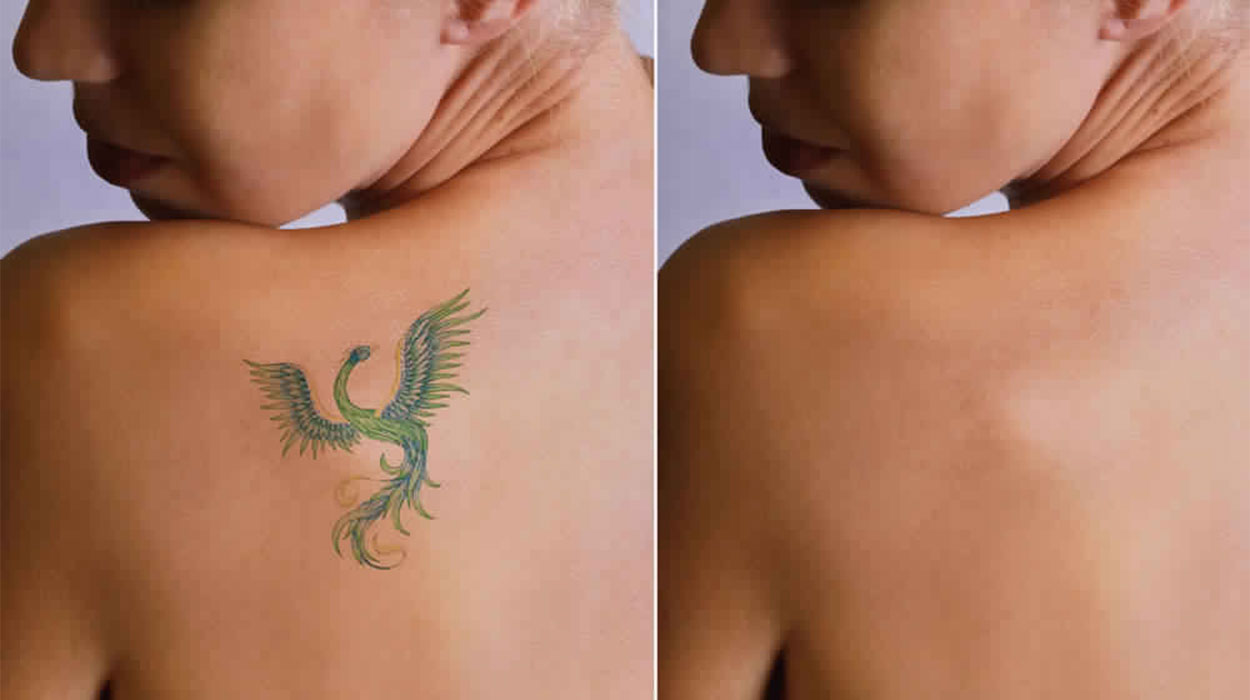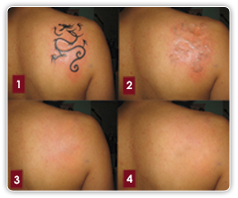Best Laser Tattoo Removal in Delhi by Experienced Skin Doctor

We employ the state-of-the-art Q-Switch laser for best laser tattoo removal in Delhi. It is a very effective method with minimal risk of scarring and lesser pain. Other options are also available too, like Dermabrasion, salabrasion, Excision and Removal Creams but they might be little painful and take time to heal.
For tattoo removal, you can find us in West Delhi (Rajouri Garden, New Rajinder Nagar, Sir Ganga Ram, & Karol Bagh).

Advanced technologies have made the procedure of tattoo removal more effective and less painful. Various methods of tattoo removal are available today, but the most beneficial process is laser technology, which involves a laser that produces light at precise wavelengths.
Laser or Q-switch is a very painless techniques for tattoo removal.
The wavelengths pass through the skin, break up the tattoo ink underneath, and allow it to dissolve and get absorbed by the body. Then, varied wavelengths are used to break up different colors of the ink wherein dark colors are the simplest to remove.
Intense pulsed light therapy or Diode uses high intensity light instead of laser light in the same way, but this procedure is less painful and more effective than traditional laser therapy. Surgical excision is yet another advanced method which allows the surgeon to remove inked areas with better control.
In this method, the surgeon removes the tattoo with a scalpel and closes the wound with stitches. Skin laser treatment in Delhi is offered at Rohit Batra’s Dermaworld Skin Institute with the help of highly experienced doctors who remove tattoos using the laser technology.
Various methods used to remove a tattoo
How to Remove Permanent Tattoo?
No matter how much one craves to get done a permanent but a most sought question keeps lingering even in the mind of tattoo lovers that— is it possible to remove a permanent tattoo permanently.
There are certain options to remove permanent tattoo from the skin without any side effects using advanced professional methods, but the potency of results depends on precision, skills and knowledge of the specialist performing it.
Here we have bring to you the different methods to remove permanent tattoo according to specific needs, skin types, time taken, recovery time, best candidate for each method& what you can expect.
Permanent Tattoo Removal: Non-Surgical Methods
Non-Surgical Methods
Laser Tattoo Removal
Laser is one of the safest and low-risk methods of tattoo removal. A little expensive than others, it is the most preferred tattoo removal technique being bloodless & most effective in removing the larger, stronger & complex tattoos.
The mechanism for laser tattoo removal works by breaking up the ink’s pigment colors with a targeted-intensity light beam (high-intensity for complex colors) that removes the tattoo without leaving the scars behind.
Black inked ones be the luckiest for lasers as black absorbs all laser wave-lengths, making it the easiest color to treat. Other colors are treated effectively using selected lasers depending upon the color of the pigment.
The right number of session typically depend upon the size and pigment of the tattoo, usually a series of treatment is done at an interval of 8-10 weeks,
Laser tattoo removal is done using two processes – ‘Passive’ and ‘Active’ laser tattoo removal system. Just because ‘Passive Laser treatment’ includes the word ‘laser’ in it, does not make it a fail-safe tattoo removal method. This is a cheaper technique of tattoo removal, but don’t get too jumpy– this will only partially fade your tattoo.
Be sure to know the difference between Passive and Active Medical-Graded Q-Switched Lasers so you aren’t ripped off, only to end up with a partly faded tattoo in name of “profitable savings”.
Dermabrasion
This is one of the options for tattoo removal that removes the top few layers of skin using abrasion methods to fade the original tattoo. Being an aggressive type, it has its own boundaries. It means that the removal of skin may result in bleeding, scarring, pain, and infections as the skin will be open after abrasion.
Dermabrasion is not meant to remove large tattoos or tattoos with solid or complex colors like black ink with a red one since the stronger color would stand out. The treatment requires multiple sessions.
If you want to try this method, look for a highly skilled specialist because if it’s not done properly, the resulting tattoo would be almost impossible to fix.
Permanent Tattoo Removal: Surgical Methods
Surgical Methods
Excision
This is a surgical way of tattoo removal where the area of skin with tattoo is ‘dig in’ (cut) making an ellipse around tattoo to remove the ink beneath epidermis layer while the remaining area is sewn closed.
The entire procedure of Excision technique takes about an hour and would require 2-3 sessions for complete removal of large tattoos. Small tattoos can be covered in one time only.
After the laser tattoo removal treatment, Excision is the next best way to go for effective and quick results. Today many tattoo shops & beauty salons have started giving tattoo removal procedures. Being a sorted surgical process, the treatment would be every inch safe & productive when performed by a specialistwho is certified and has credentials.
Skin grafting
Skin grafting is for those looking for a quicker and less painful way of tattoo removal. This method is an ideal choice for large sized & old tattoos.
Grafting tattoo removal would mean more anesthetic in which the tattooed skin is completely taken off in form of graft and a new layer of skin is grafted into it. If not done cosmetically correct, it may leave a scar on the site from where the skin is grafted.
Before recommending Skin Grafting for tattoo removal, the skin surrounding the tattoo area and the skin grafted is checked at large for any variation in color & texture for a scar-less, smooth skin after removal.
Fastest & Safest Ways of Tattoo Removal –New Laser Protocols
New Laser Protocols
Q SWITCH
An Active Q-Switched is presently the single-most effective and efficient way of removing tattoos of almost every color. The technique involves 3 types of Active Q-switch lasers – Nd:YAG, Alexandrite, and Ruby. Each laser is effective in its own way at targeting different range of the color spectrum at different wavelength – and they all produce impressive results.
Q-Switch Laser treatment is highly effective when a correct Q-Switch type is used depending upon how deep the ink is lying and how huge the ink particles are.
For dealing with green ink or pink ink, a Q-Switched Alexandrite-755nm is the best laser, with blue ink Q-Switched Ruby-694nm is most effective, while for black colored tattoos any wavelength laser can be used to easily remove it.
Tattoo removal with Q-Switch is now faster with only 2-4 sessions and also has minimal risk of scarring. If a right Q-Switch is targeted and proper aftercare is followed, the skin heals within 6-12 months.
R20
There has been a popular misconception about R20 which revolves around that R20 is a different kind of method used for tattoo removal – a kind of laser that is more proficient at removing ink. The fact is that the R20 method is simply an innovative style of treating tattoo– using a Q-Switched Laser for tattoo removal.
Rather than just one treatment pass over the tattoo like with most laser tattoo removal treatments, multiple passes spaced 20 minutes apart are performed during single patient’s visit with the aim of breaking more ink for more sizeable ink evacuation between sessions using R20. Tattoo removal is thrice more faster and more comfortable with the R0 protocol.
There has also been a debate about safety concerns & side effects linked to R20 tattoo removal treatment because of its multiple passes over single session. Actually, R20 uses the same lasers as for standard tattoo removal. The difference is not the device – instead, how that device is used. Procedure takes about 60-120 minutes. Recovery takes about 6-8 weeks in healing of the treated area.
RO Protocol
The agitation with prototypical tattoo removal has been the number of repeated sessions (10-15) it takes to remove that dire ink from the skin. With recommended 8 weeks interval in between treatments, this can take over a year to achieve final outcomes.
One restricting factor while treating a tattoo has been those white gas bubbles that forms for 20 minutes underneath skin obstructs the laser from being effective. After 20 minutes, the bubbles disappear allowing for another treatment. The 20 minutes waiting and repeating is the R20 protocol, and allows for 4 treatments in one visit.
The new edgy protocol, called the RO protocol, now knocked out the 20 minute wait between treatments. Applying a fluid called perfluorodecalin, on the skin instantly eliminates the white gas bubbles, thereby allowing 4 treatments to be performed in rapid succession.
Research shows that RO protocol have shown faster & safer removal of tattoos than from one treatment per session standard protocol.
Hit it right for saving your money and efforts choosing a well qualified dermatologist for tattoo removal.


